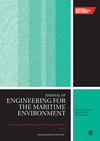Fault feature extraction, feature fusion, and severity identification approaches for AUVs with weak thruster faults
IF 1.5
4区 工程技术
Q3 ENGINEERING, MARINE
Proceedings of the Institution of Mechanical Engineers, Part M: Journal of Engineering for the Maritime Environment
Pub Date : 2024-07-29
DOI:10.1177/14750902241266118
引用次数: 0
Abstract
Fault feature extraction, feature fusion and severity identification approaches for autonomous underwater vehicles with weak thruster faults are studied in the article. The traditional method uses the modified Bayes algorithm for fault feature extraction from different signals, then the fault features are fused through the Dempster-Shafer evidence theory, and finally, the severities of the faults are obtained by the grey relation analysis method through the fused features. But for weak thruster faults, in the stage of feature extraction, it exists the problem that the ratios of fault eigenvalues to noise eigenvalues of the extracted features are low. In the stages of feature fusion and severity identification, it exists the problem that the errors of the identification results obtained from the fused fault features are not satisfactory. Aiming at the above problems, the smoothed pseudo Wigner-Ville distribution together with the modified Bayes method is presented for feature extraction for weak faults. The feature-level fusion together with the decision-level fusion method is presented for feature fusion and severity identification for weak faults. The experimental prototype pool experiments verify the effectiveness of the approaches presented in this article.针对存在弱推进器故障的自动潜航器的故障特征提取、特征融合和严重性识别方法
文章研究了自主式水下航行器弱推进器故障的故障特征提取、特征融合和严重性识别方法。传统方法采用修正贝叶斯算法从不同信号中提取故障特征,然后通过 Dempster-Shafer 证据理论对故障特征进行融合,最后通过融合后的特征采用灰色关系分析法得出故障严重程度。但对于弱推进器故障,在特征提取阶段存在提取特征的故障特征值与噪声特征值比值较低的问题。在特征融合和严重性识别阶段,存在根据融合后的故障特征得到的识别结果误差不理想的问题。针对上述问题,本文提出了平滑伪 Wigner-Ville 分布和修正贝叶斯方法,用于弱故障的特征提取。针对弱故障的特征融合和严重性识别,提出了特征级融合和决策级融合方法。实验原型池实验验证了本文介绍的方法的有效性。
本文章由计算机程序翻译,如有差异,请以英文原文为准。
求助全文
约1分钟内获得全文
求助全文
来源期刊

CiteScore
3.90
自引率
11.10%
发文量
77
审稿时长
>12 weeks
期刊介绍:
The Journal of Engineering for the Maritime Environment is concerned with the design, production and operation of engineering artefacts for the maritime environment. The journal straddles the traditional boundaries of naval architecture, marine engineering, offshore/ocean engineering, coastal engineering and port engineering.
 求助内容:
求助内容: 应助结果提醒方式:
应助结果提醒方式:


